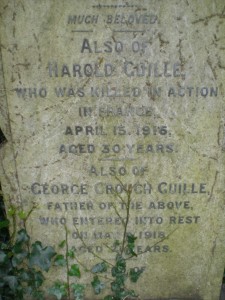E.W.Hunt
Rifleman 2216
The Queen’s (Royal West Surrey Regt.) also Queen’s Westminster Rifles
 |
Edward William Hunt lived at 74, South Street, Reading. His father was a grocer and he had an elder brother and three sisters. Edward died of wounds on 14th March 1915. He is buried in Cite Bonjean Military Cemetery, Armentieres. Location IX. C. 41. His grave is just a few yards away from that of Leslie Thomson who is also commemorated in the Reading Cemetery.
Rifleman Hunt was an old boy of Reading Collegiate School. He was employed at Liberty’s, London as an apprentice draper but joined up at the outbreak of war and was sent to the front in November 1914. The Standard 23rd March 1915, printed a letter from a friend which explained how Edward Hunt met his death. He was employed in sniping operations on the morning of his death. He had three more rounds to fire when he was shot. He was buried the following day.
Sidney Richard Hunt
Private 227059
54th Battalion Canadian Infantry (Central Ontario Regt.)
Sidney Richard Hunt was the elder brother of Edward William Hunt. The 1911 census indicates that he was seven years older than Edward. Sidney was a grocers assistant, presumably in his fathers shop. It is not known when he went to Canada.
He died on 16th October 1918 and is buried in Sauchy-Cauchy Communal Cemetery Extension, Location B. I. The village of Sauchy-Cauchy was captured by the 56th (London) Division on the 27th September 1918. The Communal Cemetery Extension was made by the division in September and October, 1918. After the Armistice graves were brought in from the German Extension and battle fields. Exact details about the death of Sidney Richard Hunt are not known.
Note: The names of these two men were noted when the Berkshire Family History Society chronicled the monument inscriptions in the Reading Cemetery in the 1990’s. When the author tried to find the names only the family headstone could be found. The body of the grave has sunk and kerbs have been removed. The grave number is 12484; BFHS classification is 66A9

